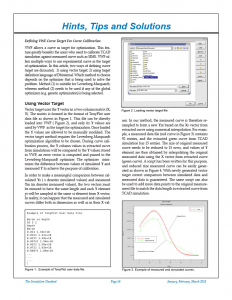Hints, Tips and Solutions
Defining VWF Curve Target For Curve Calibration
VWF allows a curve as target for optimization. This feature greatly benefits the users who need to calibrate TCAD simulation against measured curve such as SIMS. VWF offers multiple ways to use experimental curve as the target of optimization. In this article, two ways of defining curve target are discussed, 1) using vector target; 2) using target definition language of Dbinternal. Which method to choose depends on the optimizer that is being used to solve the problem. Method (1) is suitable for Levenberg-Marquardt, whereas method (2) needs to be used if any of the global optimizers (e.g. genetic optimization) is being selected.
Using Vector Target
Vector target uses the Y vector in a two-column matrix (X, Y). The matrix is formed in the format of TonyPlot user data file as shown in Figure 1. This file can be directly loaded into VWF ( Figure 2), and only its Y values are used by VWF as the target for optimization. Once loaded the Y values are allowed to be manually modified. The vector target method requires the Levenberg-Marquardt optimization algorithm to be chosen. During curve calibration process, the Y column values in extracted curve from simulations will be compared to the Y values stored in VWF, an error vector is computed and passed to the Levenberg-Marquardt optimizer. The optimizer minimizes the difference between values of simulated Y and measured Y to achieve the purpose of calibration.



